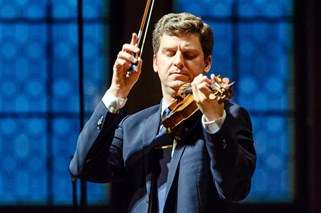|
Back
Psychedelic Virtuosity at Age 40 Ottawa
Dominion-Chalmers United Church
04/28/2016 - & May 9 (Vancouver), 10 (Kelowna), 13 (Calgary), 15 (Regina), 16 (Brandon), 18 (Winnipeg), 19 (Yellowknife), 24 (Iqaluit), 26 (London, ON), 28 (Halifax), 29 (Toronto), 30 (Niagara-on-the-Lake), 2016
George Frederic Handel: Violin Sonata in D major, Op. 1 No. 13, HWV 371
Ludwig van Beethoven: Violin Sonata No. 5, Op. 24 “Spring”
Bramwell Tovey: Stream of Limelight (world premiere)
Nikolai Rimsky-Korsakov: The Tale of Tsar Saltan: “Flight of the Bumblebee” (arr. Heifetz)
Piotr Ilyich Tchaikovsky: Souvenir de Hapsal, Op. 2: 3. “Chant sans paroles” (arr. Kreisler)
James Newton Howard: 133...At Least
Manuel Ponce: Estrellita
Fritz Kreisler: Tambourin chinois
Jean Sibelius: Berceuse, Op. 79 No. 6
Percy Grainger: Molly on the Shore
Pablo de Sarasate: Introduction and Tarantella, Op. 43
James Ehnes (violin), Andrew Armstrong (piano)

J. Ehnes (© James Whittall)
Canada’s superstar violinist James Ehnes turned forty in late January and is celebrating with a coast-to-coast tour which kicked off this week as final event for the Ottawa International Chamber Music Festival’s winter season. Ehnes was joined by his long-standing partner, American pianist Andrew Armstrong and the pair delivered a performance which was brilliant and engaging from start to finish, and ended with multiple and calorific bangs.
The program’s first half was fairly conventional, offering Sonatas by Handel and Beethoven. From the opening phrases of the Handel, Ehnes demonstrated his elegantly silken legato founded in gorgeous tone and perfect intonation from his 1715 “Marsick” Stradivarius. He was well matched by Armstrong, playing on a fine new Steinway with the lid up, a practice becoming increasingly common for chamber music and vocal recitals. The piano was strong, to be sure, but never overpowered Ehnes and the richness each player drew from his instrument was parallel and complementary. The Handel, after the lyrical first movement Affettuoso, continued with the playful Allegro, a Larghetto more melancholy than tragic, then a final Allegro both stately and joyous.
This was music making at a high level, indeed.
In Beethoven’s “Spring” Sonata, the familiar song-like opening again combined phrasing, tone and balance in a rare symbiosis. The second movement, Adagio molto espressivo could have been slower, though this arguably might been too much contrast with the exceptionally brief Scherzo with its sensuous syncopation. The closing Rondo is a cleverly fruitful combining of earlier elements from the work and brought the concert’s first half to a rich conclusion.
After intermission Ehnes and Armstrong presented the premiere of British composer-conductor Bramwell Tovey’s new work Stream of Limelight created especially for Ehnes, who spoke with the audience about Tovey’s support and mentoring since his childhood. The title refers to 19th century non-electrical theatrical lighting which was harsh and not adjustable and could challenge actors to convey radically different and shifting moods. The work opens with the violin playing a darkly ascending phrase soon joined by the piano, initially playing soft chords and harmonics which evoked late Scriabin and, sometimes, Berg and Webern. The music continued slowly for about ten minutes with the violin usually in fairly high register and sometimes very quiet, then a more agitated section, then another slower section (again often in high register) and a sudden coda with stormy chords from the piano anchoring the music.
Streams of Limelight is a brilliant, imaginative work which defies easy description or analysis but is a pleasure to hear, especially with two such superb performers. The audience, heavily populated with Chamberfest regulars, gave it a generous standing ovation.
A group of no fewer than eight encore-type showstoppers brought the evening to a spectacular conclusion and enabled Mr. Ehnes to show off his much acclaimed virtuosity without apology. If the program’s earlier repertoire had been aimed at the egghead crowd, the final section paid homage to past violin stars like Kreisler and Heifetz and gave us a time trip into earlier 20th century performance at its best. From the dizzying, literally flying notes of Rimsky-Korsakov’s The Flight of the Bumblebee, Sarasate’s Tarantella and James Newton Howard’s 133...At Least (the title is a metronome reference) through more lyrical strains of Tchaikovsky, Sibelius, Ponce and Grainger, Ehnes and Armstrong took listeners on a near psychedelic journey to the stars and back.
Charles Pope Jr.
|